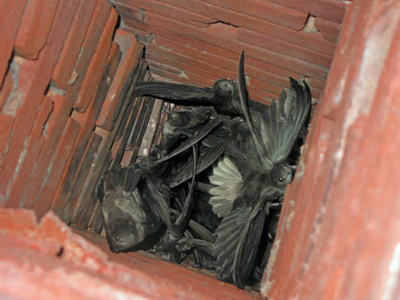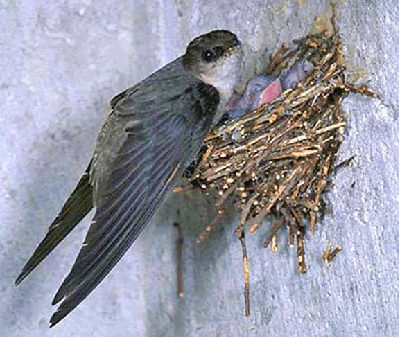When the Chirping in your Chimney is a Federal Matter
 Creatures frequently go into chimneys that are not sealed off with a chimney cap that also has wire mesh. Snakes, birds, raccoons, and other critters are usually drawn to the warmth of a chimney in winter. You can contact our chimney professionals to remove unwanted guests. There is a particular bird, however, that cannot be removed, according to federal law. If Chimney Swifts make a home in your chimney, there is a federal mandate that you must leave them there until they continue their migration route.
Creatures frequently go into chimneys that are not sealed off with a chimney cap that also has wire mesh. Snakes, birds, raccoons, and other critters are usually drawn to the warmth of a chimney in winter. You can contact our chimney professionals to remove unwanted guests. There is a particular bird, however, that cannot be removed, according to federal law. If Chimney Swifts make a home in your chimney, there is a federal mandate that you must leave them there until they continue their migration route.
You’ll usually recognize when Chimney Swifts are nesting in your chimney because you will hear high-pitched, unusual chirping coming from that direction. You will also likely notice bat-like birds circling your chimney.
Identifying Chimney Swifts
There is a unique look to Chimney Swifts. They have curved wings with about a 12-inch span and charcoal grey feathers. They are about 5 inches long and weigh approximately 1 ounce. These migratory birds are frequently mistaken for bats because of their dark hue, unusual wing shape, and the way they rapidly beat their wings during flight. Chimney Swifts usually live in the eastern United States from March through November. After that, they spend the winter months in South America.
Whereas sparrows, robins, and many other birds forage on the ground for their food, Chimney Swifts hunt for their food while in flight. These tiny birds are usually in constant flight when not either sitting on their nest to nurture their young or sleeping. They daily eat about one-third of their weight in small insects such as termites, mosquitoes, and beetles, which is a special benefit that they provide to homeowners.
You probably won’t see a chimney swift perching on tree branches or flittering across the yard because they have a difficult time going into flight from a horizontal surface. The shape of their claws and legs are ideal for latching onto vertical surfaces, such as chimney walls, caves, and the interior of hollowed trees.
Many homeowners are very surprised to learn that large groups of Chimney Swifts have made a home in their chimney, but it becomes apparent when the newly hatched baby birds begin chirping. From the time the young hatch until they migrate is about one month. Fortunately, the loud noise of chirping usually lasts for only about two weeks, as the growing birds are waiting to be fed. At the end of those two noisy weeks, the young birds are usually strong enough to handle making the lengthy journey to South America.
About Federal Protection of Chimney Swifts
 Federal law prohibits the removal of occupied Chimney Swifts nests and the removal of the birds themselves. Chimney Swifts are migratory birds and are therefore protected under the Migratory Bird Treaty Act. The thinning of forests has contributed to the declining population of Chimney Swifts, due in particular to the routine removal of hollow trees. As homeowners have increasingly been using metal flue liners and chimney caps, it has become challenging for these migratory birds to find homes in which they can rear their young. Metal flues prevent the birds from attaching themselves to the sides, and the birds easily get trapped in stainless steel liners.
Federal law prohibits the removal of occupied Chimney Swifts nests and the removal of the birds themselves. Chimney Swifts are migratory birds and are therefore protected under the Migratory Bird Treaty Act. The thinning of forests has contributed to the declining population of Chimney Swifts, due in particular to the routine removal of hollow trees. As homeowners have increasingly been using metal flue liners and chimney caps, it has become challenging for these migratory birds to find homes in which they can rear their young. Metal flues prevent the birds from attaching themselves to the sides, and the birds easily get trapped in stainless steel liners.
After Chimney Swifts have made a home in your chimney, there are droppings that need to be removed as well as nests. Contact our certified professional chimney technicians for chimney cleaning and for installation of a chimney cap, which keeps out moisture as well as unwanted critters. Many people who are concerned about these unique birds have chimney-shaped bird houses installed in their yards to accommodate Chimney Swifts when they return the following spring.








